Weightlifting Mesocycles Part 2: General Strength for Weightlifters
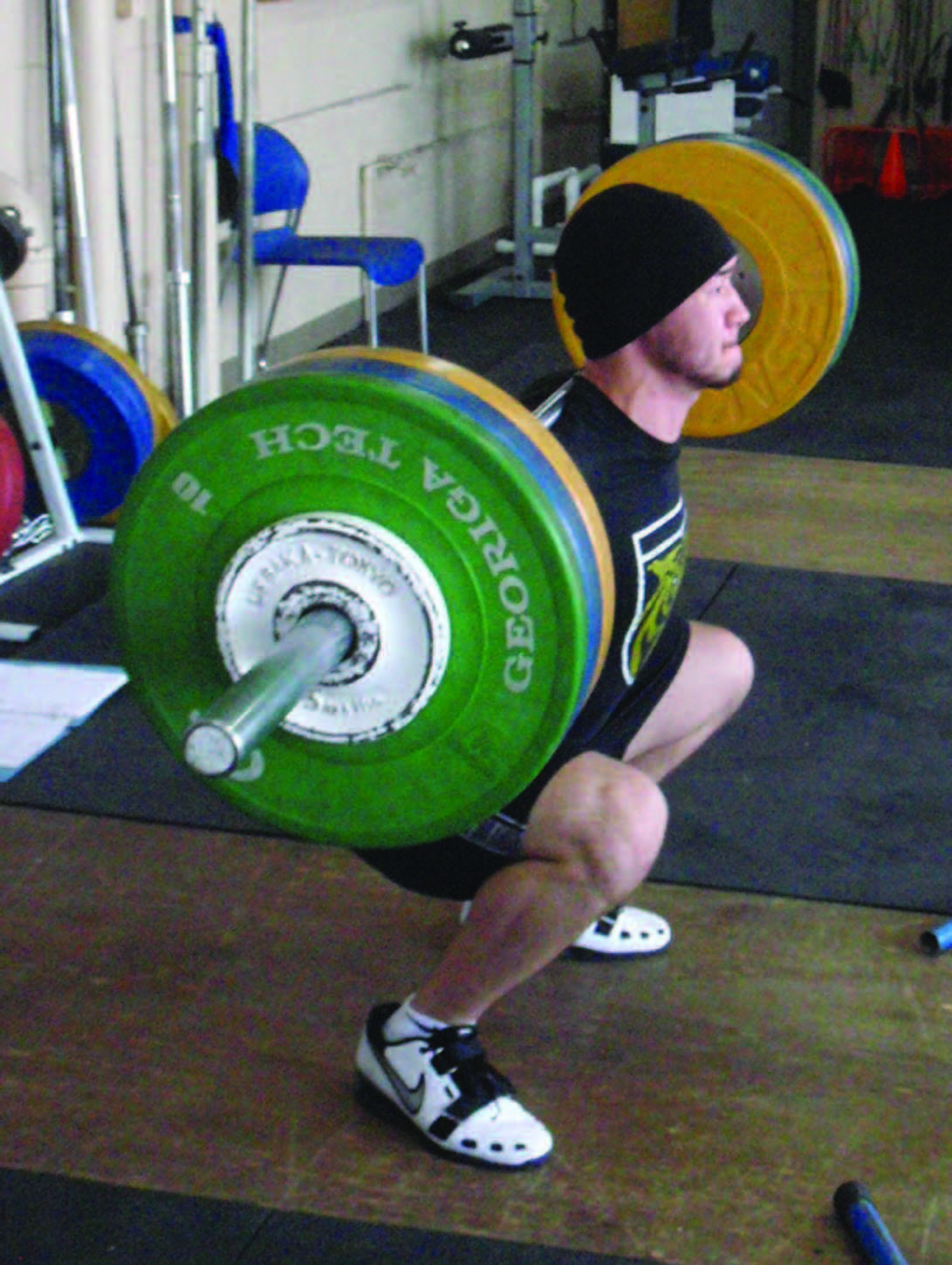
Last month’s topic was the importance of general physical preparation (GPP). This month, we will focus on the significance of general strength. Many lay people misinterpret weightlifting as a technical sport, meaning its all technique requiring little strength. Likewise, some weightlifting coaches emphasize only the technical aspect of the sport and don’t spend the necessary amount of time in general strength development. Although the sport of weightlifting has a large technical element, one must still be strong! Some people ask, “Would you rather have a technically efficient weightlifter or a genetically strong weightlifter?” Naturally, any coach’s answer would be both. Yet if one would have to choose, it takes less time to develop a technically efficient weightlifter than to build strength, especially if coaches start athletes from day one. In most cases, a majority of a coach’s time is spent developing both. This article will focus on how Front Range Weightlifting Club transitions its athletes from the general physical preparation cycle to the general strength cycle.
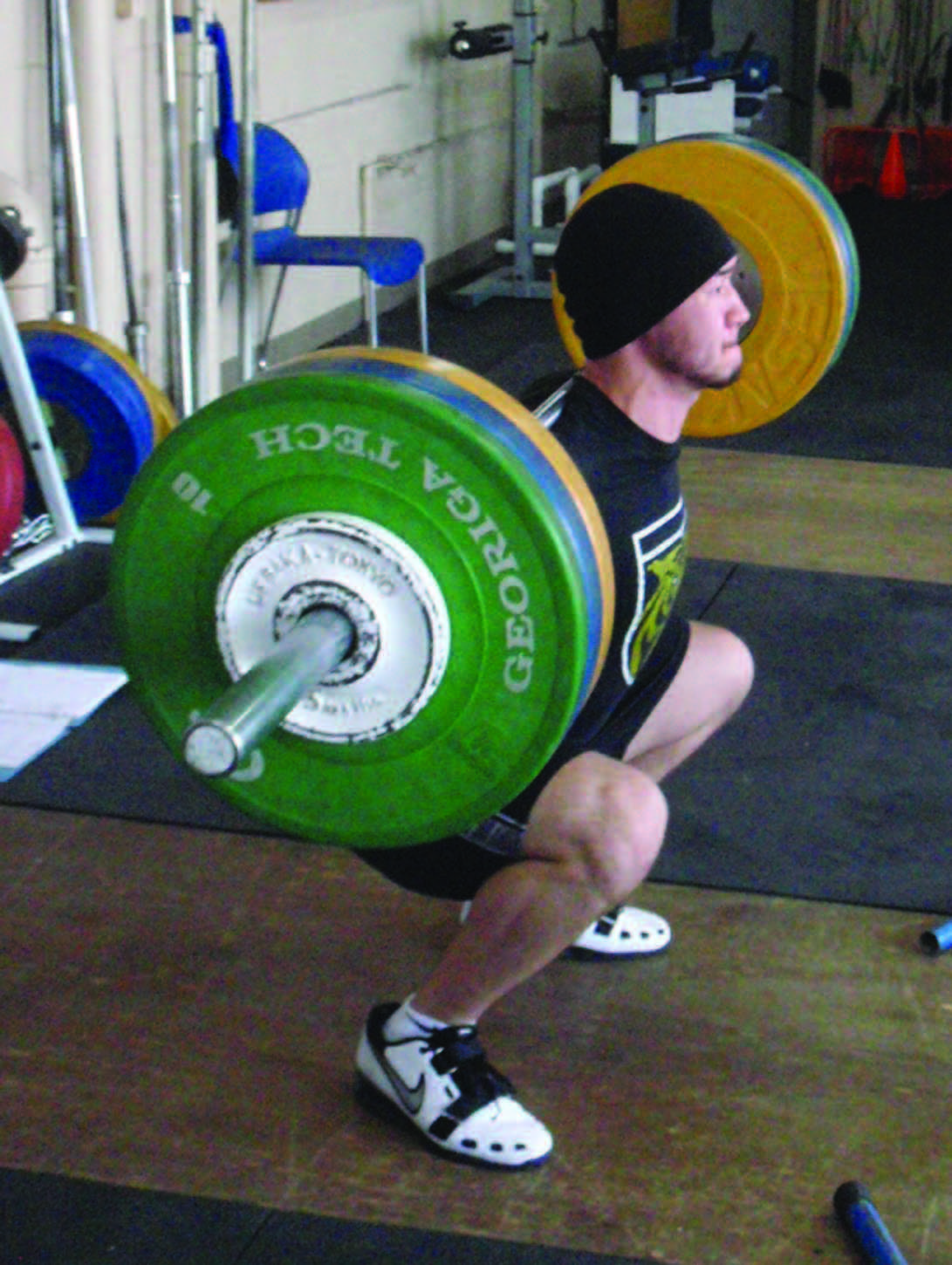
The Basic Structure
The GPP mesocycle included weeks sixteen through thirteen prior to the competition. The general strength cycle includes weeks twelve through nine. Given the athletes are healthy and had a productive GPP cycle and you are continuing with beginning lifters in years one through three, the components emphasized in general strength are sustained technique work for all of the movements and increased emphasis on leg, pulling and overhead strength and stability. Consequently, athletes will see a slight decrease in overall volume, though average intensity will increase. Nevertheless, exercises to increase work capacity and basic cardiovascular conditioning, such as the circuits from the GPP cycle, will still be used but not emphasized. The formerly established format of starting with a general warm-up, then a more specific dynamic warm-up, a plyometric, the weightlifting exercises and core work remain steadfast.
Warming up
A general warm-up of rowing 500 to 750 meters, jumping rope, heavy rope, double- unders or low level sprints are still incorporated. Medicine ball, barbell, dumbbell, kettlebell or bodyweight circuits are still integrated, although with less volume and higher intensities. The aforementioned circuits will now have four to five exercises with five to eight repetitions but are still performed with minimal to no rest between exercises within the circuit.
The warm-up is still followed by either an explosive or reactive plyometrics, although explosive plyos are stressed. Plyometric exercises that include both qualities such as hurdle jumps plus a box jump and depth jumps plus a box jump are also introduced. In addition, an explosive plyo may be inserted into the weightlifting workout periodically. For example, doing a set of squats followed immediately by a set of box jumps is an occurrence called muscle potentiation. Research indicates that after a maximum voluntary contraction, jump height is significantly higher. Therefore, if the muscle is fatigued prior to an explosive neuromuscular movement, it would require the neuromuscular system to recruit more motor units to perform the movement consequently, increasing power through intramuscular coordination.
Volume & Intensity
As with the GPP mesocycle, athletes use the most amount of weight possible in their sets with good technique. As soon as technique breaks down, they are asked to lower the weight to compete the sets and reps.
Likewise, in this mesocycle, there will be three hard training weeks and a fourth recovery/unloading week. Volume will still be non-linear, varying between 200-250 repetitions per microcycle, though. Again, the diversity between volume and intensity in the first three microcycles in the general strength mesocycle will not have great disparity. However, the recovery/unloading week will typically show less average volume (closer to 200 repetitions) but greater average intensities, at or above 85% of the lifter’s one repetition maximum in the respective lifts.
There will be less exercise selection in this cycle than the GPP mesocycle, but this cycle will still stress lifts from different positions and complex lifts will still be incorporated. Volume in these exercises will also stay relatively high. Volumes for traditional lifts will not be more than three repetitions. However, when incorporating complex lifts, volumes will be between three and eight reps per set. Leg strengthening movements will vary between five to six repetitions while pulling and overhead movements will remain between five and six reps.
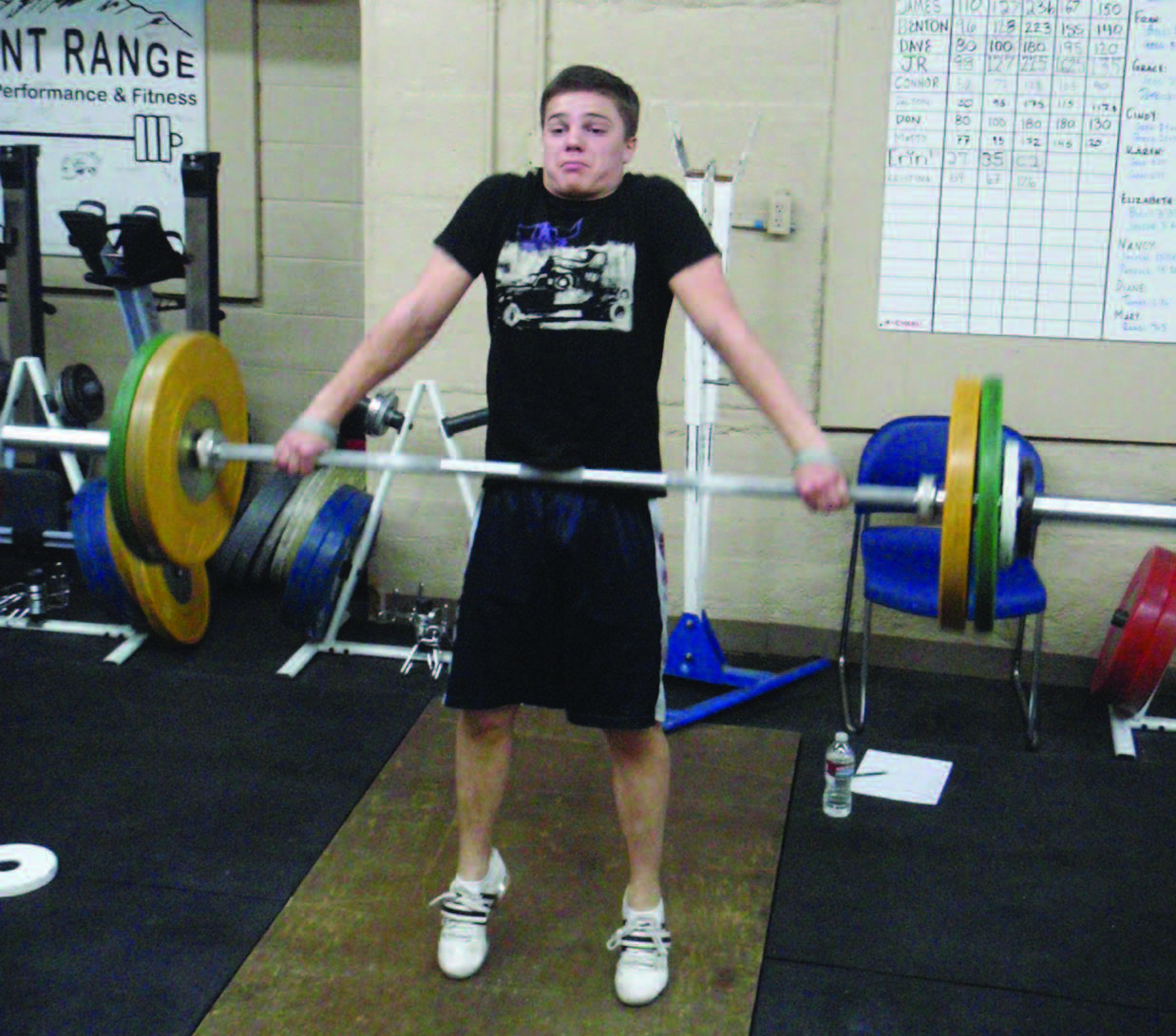
Exercise Selection
Let’s restate the goals of this mesocycle: proper technique and increased emphasis on leg, pulling and overhead strength and stability while emphasizing complex lifts and lifts from different positions. The following might be a typical microcycle for the general strength phase.
Day 1:
General warm-up: Bodyweight circuit
• 20 Jumping Jacks
• 10 Squats
• 10 Handstand push-ups
• 10 Lunges
• 10 Push-ups
• 10 Pistols each leg
Specific warm-up: DB complex (no rest between exercises):
• 8 Upright row
• 8 Muscle snatch- below knee
• 8 Thrusters
• 8 Stiff leg dead lifts
• 8 Bent-over row
Plyometric: Squat jumps with bar: 2x8
Weightlifting workout:
1. Snatch + snatch below knee: 5x1+2
• Performed as one snatch from the floor and two from below the knee
2. Clean + front squat + power jerk: 4x1+2+2
• Performed as one clean two front squats and two power jerks
3. Snatch pulls: 4x5
4. Front squats: 4x4
5. Core & Assistance:
• Weighted back extension: 2x8
• Weighted abs: 2x8
• Kettlebell swings: 2x8
Total reps: 79
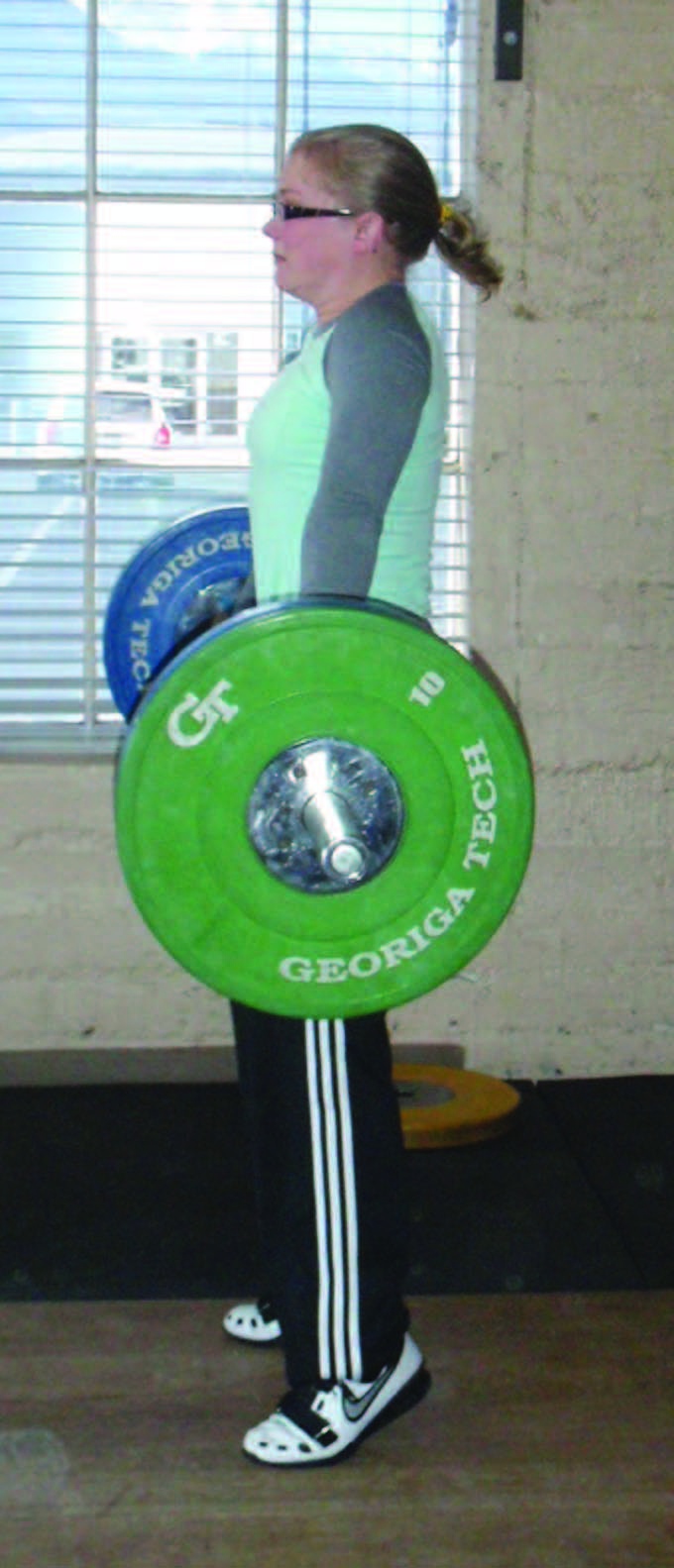
Bodyweight circuit, DB complex and loaded squat jumps are a comprehensive warm-up. Exercise 1, snatch + snatch below knee, is a traditional lift followed by two movements from a different position. This exercise forces the lifter to hold the proper positions with heavier weights while working through muscle fatigue. As the load gets heavier, it will be increasingly harder to keep the shoulders over the bar and keep the knees back in order to brush high on the thigh. Many lifters, when fatigued, push the knees forward so the hips take on the load instead of the muscles of the posterior chain. By pushing the knees forward prematurely, the bar brushes too low on the thighs and consequently, the lifter will have poor acceleration on the barbell, which will result in poor technique or a missed lift.
Exercise 2, clean + front squat + power jerk, is a complex movement focusing on technique and anaerobic capacity. The first two movements will fatigue the lifter and will force the athlete to hold the proper positions for the power jerk, especially the dip and drive of the movement. The order of the movements are done this way so the lifter gets used to doing an overhead movement when fatigued, much like after a hard clean in a competition. Snatch pulls, front squats and core & assistance will round out the workout.
Day 2:
General warm-up: 25 double unders or 50 heavy rope skips or 75 rope skips
Specific warm-up: Dynamic circuit (minimal rest between exercises):
• 10 Ball slams
• 10 Overhead squats using the bar
• 10 MB cleans
• 10 Thrusters using the bar
Plyometric: Skier hops over a hurdle: 3x12
Weightlifting workout:
1. Snatch balance: 4x4
2. Snatch from 3 positions: 4x1+1+1
• Positions are from floor, above knee and below knee
3. Clean + jerk: 5x2+3
• Perform two cleans first and then three jerks
4. DB walking lunges: 3x8
5. Core & Assistance:
• Static hold: 2x30 seconds
• Kneeling med ball side throws: 2x10 each side
• Alternate DB press: 2x8 each arm
Total reps: 77
Following the warm up and plyo, snatch balance is an excellent overhead strength and stability exercise, not only for beginners but for advanced lifters as well. Snatch from 3 positions is an excellent developer of consistent technique. Many athletes’ technique will vary throughout a movement. For example, the athlete may have solid technique when performing the movement from the floor but hen the athlete starts above the knee he might push the knees forward too soon. This exercise can unearth these inconsistencies and give the coach more insight about the athletes’ tendencies and focus on assistance exercises to remedy these. Likewise, breaking up a traditional movement like clean & jerk to clean + jerk will allow the coach to focus on the overhead movement when the athlete is fatigued and again, give the coach information on a weakness of the athlete and possible assistance exercises.
Lunging, again, is a good assistance exercise for the hamstrings and glutes. As athletes get stronger, it is important that the antagonistic muscles of the quads and hip flexors be of equal strength. Core and assistance exercises end the workout.
Day 3:
General warm-up: Row 500 meters
Specific warm-up: Plyo Circuit
• 50 Double unders or practice for 2’
• 8 Box jumps
• 16 Lunge squat jumps
• 10 DB thrusters w/ a jump
Weightlifting workout:
1. Muscle snatch: 3x5
2. Snatch: 4x3
• Positions are from floor, above knee and below knee
3. Clean & jerk: 5x2+3
• Perform two clean & jerks then one jerk
4. Clean pulls: 4x5
5. Squats + box jump: 4x6+3
6. Core & Assistance:
• Manual assisted reverse hypers: 2x8
• Toes to bar: 2x8
• Biceps: 2x8 each arm
Total reps: 96
Total weekly volume: 252 reps
Following the 500-meter row, a short yet effective plyometric circuit can be implemented as the specific warm up to awaken the neuromuscular system. Muscle snatch, similar to high pull + snatch, is effective in ensuring high elbows and developing a good transition of the arms in the snatch movement. Adding an extra jerk in exercise 3 will again show tendencies or weaknesses in the overhead movement of the lifter when fatigued. In exercise 5, the box jump should be performed within thirty seconds of finishing the squats for the greatest effect of muscle potentiation.
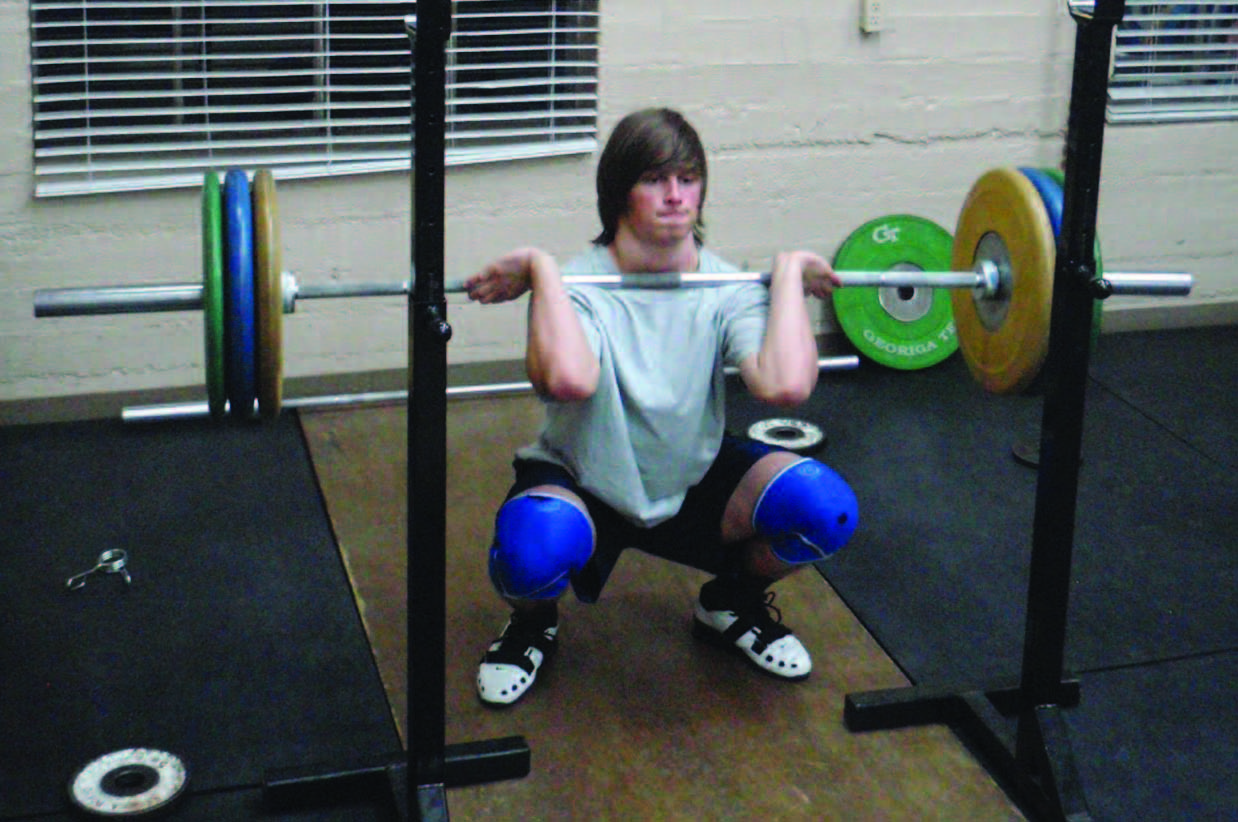
In Conclusion
Following the GPP phase, the general strength phase will tie the two cycles together and prepare the athlete for the next cycle: conversion to power.
An inclusive general strength program will help tie the GPP phase and the strength phase together. To better prepare athletes both physically and mentally for maximal lifts in the competition phase down the road, it is critical the athlete experience the diversity of a general strength cycle. Athletes will be fatigued and it is up to the coach to nurture and assist their athletes through these demanding training sessions. As athletes broaden their foundation, more will be asked of them. This approach, sometimes referred to as progressive overload, will ensure constant improvement, garner confidence and establish a solid relationship between athlete and coach.

The Basic Structure
The GPP mesocycle included weeks sixteen through thirteen prior to the competition. The general strength cycle includes weeks twelve through nine. Given the athletes are healthy and had a productive GPP cycle and you are continuing with beginning lifters in years one through three, the components emphasized in general strength are sustained technique work for all of the movements and increased emphasis on leg, pulling and overhead strength and stability. Consequently, athletes will see a slight decrease in overall volume, though average intensity will increase. Nevertheless, exercises to increase work capacity and basic cardiovascular conditioning, such as the circuits from the GPP cycle, will still be used but not emphasized. The formerly established format of starting with a general warm-up, then a more specific dynamic warm-up, a plyometric, the weightlifting exercises and core work remain steadfast.
Warming up
A general warm-up of rowing 500 to 750 meters, jumping rope, heavy rope, double- unders or low level sprints are still incorporated. Medicine ball, barbell, dumbbell, kettlebell or bodyweight circuits are still integrated, although with less volume and higher intensities. The aforementioned circuits will now have four to five exercises with five to eight repetitions but are still performed with minimal to no rest between exercises within the circuit.
The warm-up is still followed by either an explosive or reactive plyometrics, although explosive plyos are stressed. Plyometric exercises that include both qualities such as hurdle jumps plus a box jump and depth jumps plus a box jump are also introduced. In addition, an explosive plyo may be inserted into the weightlifting workout periodically. For example, doing a set of squats followed immediately by a set of box jumps is an occurrence called muscle potentiation. Research indicates that after a maximum voluntary contraction, jump height is significantly higher. Therefore, if the muscle is fatigued prior to an explosive neuromuscular movement, it would require the neuromuscular system to recruit more motor units to perform the movement consequently, increasing power through intramuscular coordination.
Volume & Intensity
As with the GPP mesocycle, athletes use the most amount of weight possible in their sets with good technique. As soon as technique breaks down, they are asked to lower the weight to compete the sets and reps.
Likewise, in this mesocycle, there will be three hard training weeks and a fourth recovery/unloading week. Volume will still be non-linear, varying between 200-250 repetitions per microcycle, though. Again, the diversity between volume and intensity in the first three microcycles in the general strength mesocycle will not have great disparity. However, the recovery/unloading week will typically show less average volume (closer to 200 repetitions) but greater average intensities, at or above 85% of the lifter’s one repetition maximum in the respective lifts.
There will be less exercise selection in this cycle than the GPP mesocycle, but this cycle will still stress lifts from different positions and complex lifts will still be incorporated. Volume in these exercises will also stay relatively high. Volumes for traditional lifts will not be more than three repetitions. However, when incorporating complex lifts, volumes will be between three and eight reps per set. Leg strengthening movements will vary between five to six repetitions while pulling and overhead movements will remain between five and six reps.

Exercise Selection
Let’s restate the goals of this mesocycle: proper technique and increased emphasis on leg, pulling and overhead strength and stability while emphasizing complex lifts and lifts from different positions. The following might be a typical microcycle for the general strength phase.
Day 1:
General warm-up: Bodyweight circuit
• 20 Jumping Jacks
• 10 Squats
• 10 Handstand push-ups
• 10 Lunges
• 10 Push-ups
• 10 Pistols each leg
Specific warm-up: DB complex (no rest between exercises):
• 8 Upright row
• 8 Muscle snatch- below knee
• 8 Thrusters
• 8 Stiff leg dead lifts
• 8 Bent-over row
Plyometric: Squat jumps with bar: 2x8
Weightlifting workout:
1. Snatch + snatch below knee: 5x1+2
• Performed as one snatch from the floor and two from below the knee
2. Clean + front squat + power jerk: 4x1+2+2
• Performed as one clean two front squats and two power jerks
3. Snatch pulls: 4x5
4. Front squats: 4x4
5. Core & Assistance:
• Weighted back extension: 2x8
• Weighted abs: 2x8
• Kettlebell swings: 2x8
Total reps: 79

Bodyweight circuit, DB complex and loaded squat jumps are a comprehensive warm-up. Exercise 1, snatch + snatch below knee, is a traditional lift followed by two movements from a different position. This exercise forces the lifter to hold the proper positions with heavier weights while working through muscle fatigue. As the load gets heavier, it will be increasingly harder to keep the shoulders over the bar and keep the knees back in order to brush high on the thigh. Many lifters, when fatigued, push the knees forward so the hips take on the load instead of the muscles of the posterior chain. By pushing the knees forward prematurely, the bar brushes too low on the thighs and consequently, the lifter will have poor acceleration on the barbell, which will result in poor technique or a missed lift.
Exercise 2, clean + front squat + power jerk, is a complex movement focusing on technique and anaerobic capacity. The first two movements will fatigue the lifter and will force the athlete to hold the proper positions for the power jerk, especially the dip and drive of the movement. The order of the movements are done this way so the lifter gets used to doing an overhead movement when fatigued, much like after a hard clean in a competition. Snatch pulls, front squats and core & assistance will round out the workout.
Day 2:
General warm-up: 25 double unders or 50 heavy rope skips or 75 rope skips
Specific warm-up: Dynamic circuit (minimal rest between exercises):
• 10 Ball slams
• 10 Overhead squats using the bar
• 10 MB cleans
• 10 Thrusters using the bar
Plyometric: Skier hops over a hurdle: 3x12
Weightlifting workout:
1. Snatch balance: 4x4
2. Snatch from 3 positions: 4x1+1+1
• Positions are from floor, above knee and below knee
3. Clean + jerk: 5x2+3
• Perform two cleans first and then three jerks
4. DB walking lunges: 3x8
5. Core & Assistance:
• Static hold: 2x30 seconds
• Kneeling med ball side throws: 2x10 each side
• Alternate DB press: 2x8 each arm
Total reps: 77
Following the warm up and plyo, snatch balance is an excellent overhead strength and stability exercise, not only for beginners but for advanced lifters as well. Snatch from 3 positions is an excellent developer of consistent technique. Many athletes’ technique will vary throughout a movement. For example, the athlete may have solid technique when performing the movement from the floor but hen the athlete starts above the knee he might push the knees forward too soon. This exercise can unearth these inconsistencies and give the coach more insight about the athletes’ tendencies and focus on assistance exercises to remedy these. Likewise, breaking up a traditional movement like clean & jerk to clean + jerk will allow the coach to focus on the overhead movement when the athlete is fatigued and again, give the coach information on a weakness of the athlete and possible assistance exercises.
Lunging, again, is a good assistance exercise for the hamstrings and glutes. As athletes get stronger, it is important that the antagonistic muscles of the quads and hip flexors be of equal strength. Core and assistance exercises end the workout.
Day 3:
General warm-up: Row 500 meters
Specific warm-up: Plyo Circuit
• 50 Double unders or practice for 2’
• 8 Box jumps
• 16 Lunge squat jumps
• 10 DB thrusters w/ a jump
Weightlifting workout:
1. Muscle snatch: 3x5
2. Snatch: 4x3
• Positions are from floor, above knee and below knee
3. Clean & jerk: 5x2+3
• Perform two clean & jerks then one jerk
4. Clean pulls: 4x5
5. Squats + box jump: 4x6+3
6. Core & Assistance:
• Manual assisted reverse hypers: 2x8
• Toes to bar: 2x8
• Biceps: 2x8 each arm
Total reps: 96
Total weekly volume: 252 reps
Following the 500-meter row, a short yet effective plyometric circuit can be implemented as the specific warm up to awaken the neuromuscular system. Muscle snatch, similar to high pull + snatch, is effective in ensuring high elbows and developing a good transition of the arms in the snatch movement. Adding an extra jerk in exercise 3 will again show tendencies or weaknesses in the overhead movement of the lifter when fatigued. In exercise 5, the box jump should be performed within thirty seconds of finishing the squats for the greatest effect of muscle potentiation.

In Conclusion
Following the GPP phase, the general strength phase will tie the two cycles together and prepare the athlete for the next cycle: conversion to power.
An inclusive general strength program will help tie the GPP phase and the strength phase together. To better prepare athletes both physically and mentally for maximal lifts in the competition phase down the road, it is critical the athlete experience the diversity of a general strength cycle. Athletes will be fatigued and it is up to the coach to nurture and assist their athletes through these demanding training sessions. As athletes broaden their foundation, more will be asked of them. This approach, sometimes referred to as progressive overload, will ensure constant improvement, garner confidence and establish a solid relationship between athlete and coach.
| Paul Fleschler is the owner of Front Range Sports Performance & Fitness and RedRocks CrossFit in Colorado Springs. He earned a masters degree in Motor Control and Learning from Indiana University, is a Certified Strength & Conditioning Specialist and USA Weightlifting Senior International Coach where he has represented the United States at several international weightlifting competitions as Head and Assistant Coach. As an athlete, Paul’s greatest honor was representing the United States at the 1992 Barcelona Olympics. Paul is the former Men’s National Coach and former Men’s and Women’s Resident Coach at the Olympic Training Center in Colorado Springs. He also served in a supportive role for USA Weightlifting at the 2004 and 2008 Olympic Games. Paul assisted with 20 varsity sports at Indiana University, and served as the Head Strength Coordinator for Indiana University Basketball. |
Search Articles
Article Categories
Sort by Author
Sort by Issue & Date
Article Categories
Sort by Author
Sort by Issue & Date

